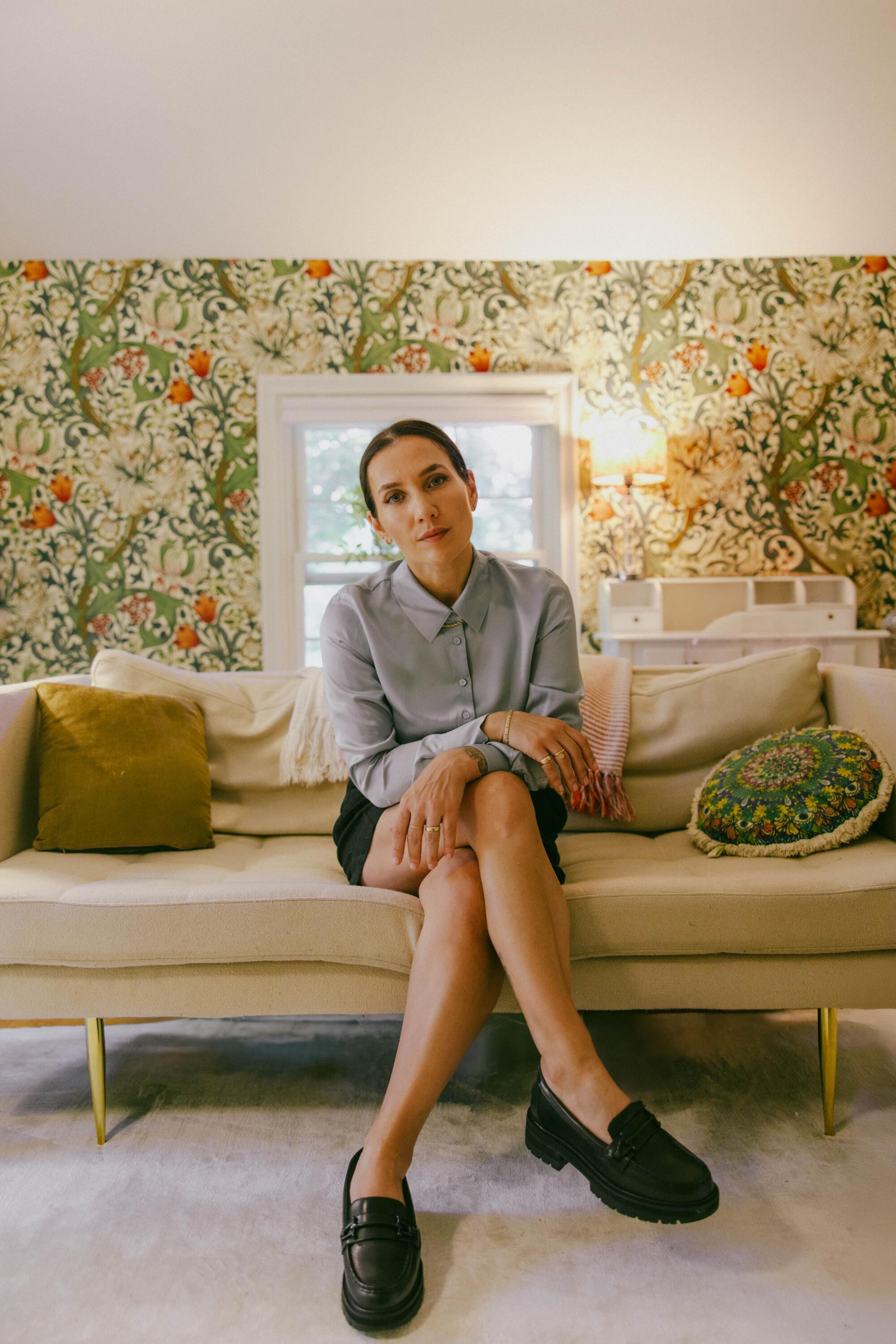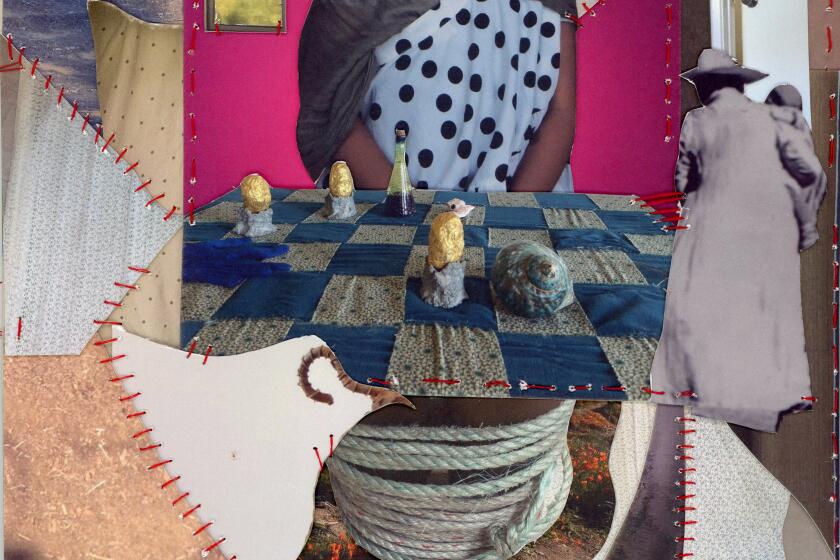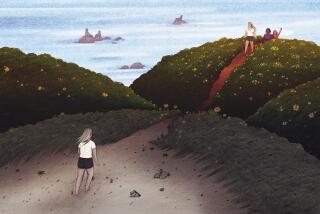
This story is part of Image’s October Luxury issue, exploring what luxury really means to artists, designers, aestheticians, architects and more.
It is summer in the Midwest, hot as soup, and I don a frock the size of a twin bed sheet in cooling cotton. “Going full women’s studies professor today, are we?,” my wife comments appreciatively. I give her a magisterial stare over the top of my reading glasses. “Where are my clogs?,” I ask, just for the theater of it. (It’s much too hot for clogs.)
I am cruising toward my mid-40s and freer every minute. Gone are the stilettos that filled the closets of my youth, gone are the corsets and shapewear and thongs. I am living a life beyond my wildest dreams, in a literal sense; I never knew to dream of this.

I was not a tasteful young person, not in my clothing anyway. Partly this was due to the body dysmorphia I suffered from, beginning in adolescence, when I developed early. I was already weird, with parents who sat outside the mainstream, before I reached an age where that became interesting. They had no interest in trends or keeping up with anyone. We were brand-ignorant and thrifty, middle class but with poor origins. To pay more than a shirt was worth for status was abhorrent, alien to my parents.

I was smart and artistic, qualities that didn’t count for much as a middle-schooler. And when I was 11, my body changed dramatically, ahead of the schedule my peers were on. I walked down the school hallways in my new body amid my child-shaped classmates and felt ungainly and over-sexual, grotesque, as if I’d been turned inside out.
Clothes became a means of disguise. Although I had more options in my closet, I cycled through only two pairs of jeans for all of fifth grade because I had doused them in magical thinking, believed they were the only pants that could mask the thighs I now sported.
Meanwhile, on the streets of my town, grown men stared. Their probing gazes frightened and excited me. I’d learned from magazines and television that this was a kind of power, whether I knew how to wield it or not. I vacillated frenetically between oversize and undersize clothes, ambivalent about whether I wanted to draw attention or repel it.
Chris Kraus and Catherine Lacey, two writers of two generations, talk mixing genres, daily schedules, and the critics.
This was the early ’90s. I had grown up studying supermodels like Cindy Crawford, Christy Turlington and Naomi Campbell, amazons with rivers of hair and powerful strides, but right around the time my body changed, so did our beauty ideals. Now, it was Kate Moss and heroin chic. Suddenly, even adult celebrities looked like consumptive children. I quickly developed an eating disorder.
What a mercy that I was queer and raised by a feminist. Ideology couldn’t cure my eating disorder or distorted body image, but it did give me an intellectual framework to understand that I had been brainwashed by patriarchy and commerce.

By the time I was 14, I had found Ani DiFranco and other queer kids, stopped shaving my armpits and legs and had begun wearing overalls and men’s undershirts. I bought slippery polyester button-downs and oversize men’s pants at local thrift stores. I cut the necks out of my T-shirts and shaved my head. I got a girlfriend, and then another.

My body changed again in my later teens, when I developed a drug addiction and got skinny for the first time. I was known in college for donning knee socks and miniskirts just shy of indecent. A friend of mine once said, “Melissa, you have the most demented style of anyone I know. One day you’ll be wearing this dope outfit, and the next, some wild macramé nightmare.” I felt both insulted and complimented. It made sense to me too. I knew that my self-image was wildly fluctuating, and so it followed that my style would too.
In those years, I was a shape-shifter, a different person with each of my disparate groups of friends. This sort of chameleon behavior is common among 20-year-olds, sure, but being an addict exacerbated the situation. I had things to hide, whole swathes of myself that would be unacceptable in some relationships. So my groups of friends were all siloed from each other. Clothes were a tool that helped me play the part: of college student (a perfectly worn Pixies T-shirt and jeans), off-the-clock dominatrix (stilettos and a leather bomber jacket), intern (cardigans and blazers), junkie on the Lower East Side with nothing significant enough to be worth robbing (battered black Chucks and a patched hoody).
Everyone suddenly, it seems, wants to lucid dream. I say: First dream, but dream actively. Here are some practices I take to ensure an engagement in my Dream Life.
After I got clean when I was 23, I evened out my style a bit, though it remained erratic. Some days it was closer to my ’90s queer teen style and others a ’50s-inspired high femme. On the streets of New York, this meant drawing the gazes of entirely different demographics from day to day. Clothes were still a tool to manage the gaze of others: to influence who saw me and how.
At 20, I delighted in this sartorial fluidity. I observed women twice my age — at the front of my classrooms or dining in my favorite vegan restaurant — in their flowing garments and artistic jewelry and feared that someday, when I was old and wizened like them, a mysterious authority would swoop in to confiscate my miniskirts and stilettos and torn-up sweaters and issue me a new wardrobe of linen pants and drapey cardigans and flat shoes from Clarks.

More often, I wondered what would happen after my youth ended. I didn’t want to look ridiculous. I was a young queer feminist but still full of unexamined ideas. I believed that to dress the same in midlife as I had in my 20s would make me a punchline. But where was the threshold? Middle age seemed like a kind of afterlife, the dreary pasture where you wiled away your post-sex, post-fun years in drab, shapeless garments. Whatever the gender of my future partner, I assumed that I would have children, that birthing them would ruin my body and that exhaustion would sap me of all aesthetic concern. What a vision! How happy it has been to discover my youthful ignorance as the true punch line.

When I met my wife when I was 36, I was still wearing heels most days. “Are you sure you’re comfortable in those?,” she was forever asking me. I responded with impatience, “Of course.” By that age, I had switched mostly to wedges for everyday use; that seemed essentially the same as wearing sneakers to me. I would occasionally admire a well-made pair of flat shoes in a shop window, and she would encourage me to try them on. “No, no,” I’d say. “I’m too short and my feet are too big — I’d look like a troll.” She disagreed, but I knew I was right. I’d been disguising my body for my whole life, after all.
Footwear was one of the last vestiges of my old relationship to clothes. The year before I’d met my wife had been a pivotal one. In my mid-30s, after a horrific breakup, I realized that I hadn’t been single since my teens. I decided to spend some time celibate, to abstain not only from sex but also all the attendant activities, including dating and even flirting. Almost immediately, I noticed the difference in every realm of my life.

I was unpartnered and uninterested in pursuing romantic prospects, and my days opened up. I fell in love with solitude. I tended my friendships with new passion. I ate and slept and wrote when it suited me. And my clothing changed. For the first time ever, I enjoyed true privacy with my own tastes. I was free of the need to appeal to anyone. What did I actually like, in the absence of that old familiar imperative? A well-tailored sack, it turned out. The perfect Oxford shirt. I grew out my body hair and stopped wearing most makeup. I walked the streets of New York blissfully invisible to straight men. Some days I returned to my high femme staples, but only when it suited my mood.
Still, it took more than a year to fully confront my internalized fat phobia and accept my body. It took decades of therapy and spiritual practice. It took finally reaching midlife. I know who I am, finally, and she doesn’t need a disguise. I no longer feel like the outsider teen, playing adult. I surround myself with people equally concerned with liberating their minds and bodies. Being loved wholly by someone I plan to spend the rest of my life with has helped too.
Rather than the dreary pasture where fun and sex go to die, middle age has turned out to be a verdant place where I don’t give a s— about the male gaze, whether internalized or external. At 43, I can’t imagine caring less what straight men think of my personal style. The only male gaze I value these days is that of a particular stripe of middle-age gay: five to 15 years older than me with good skin and a nice watch and expensive leather shoes; I’ll take his compliment. But mostly, I now truly dress for myself and my beloveds, who all want me to be comfortable and have a good time.


What a wonderful surprise to find that life has not turned out like I thought it would. I am a writer, as I always planned, but I chose not to have children. I live not in New York City, where I thought I’d stay forever, but in Iowa City, Iowa. I am therefore able to use my expendable income to help out my friends with children and to populate my wardrobe with the clothes I never imagined existed when I was 20.
I was not issued relegation linens on my 40th birthday, although I do love linen. I don’t have a single Eileen Fisher item in my closet, but I adore shoes from Clarks. For everyday outfits, I rely on staples from Boden, Madewell, Quince and Theory. I love an artful sack, like those from Marimekko and Muji. I still like to play with different looks, but I have a more consistent style than ever, one that comprises bits of all my past selves. Oversize pants and tops from Roucha, cashmere and button-downs from Seźane. I still love a corset top (Horses Atelier) and a sweater vest (Madewell) and have miraculously fallen for the cropped tee (Big Bud) — something I never wore even when I was young. I swoon for a well-made pencil skirt and an artful blouse (The Fold, M.M.LaFleur). I own multiple suits (Indochino, Bindle & Keep) but am happiest in a perfect pair of jeans (Everlane, Paige) and a white T-shirt (Marine Layer). On my feet, you’ll find white Asics Onitsuka Tigers these days — a far cry from wedges.
Every time I think of my old idea of midlife — that dreary pasture full of drab linens — laughter bubbles out of me. Imagine being bored in middle age. The real pleasures of midlife manifest in less material ways: in my creative practice and my relationships, but the effect on my wardrobe isn’t small. I thought my closet, like my life, would decrescendo with time, and it’s done the opposite. At age 20, I could never have imagined the luxury of this freedom. I can’t wait to see what comes next. If this is middle age, then getting old is going to be a wild ride.

Melissa Febos is the author of five books, including her forthcoming memoir “The Dry Season,” now available for preorder from Alfred A. Knopf. She teaches at the University of Iowa.








